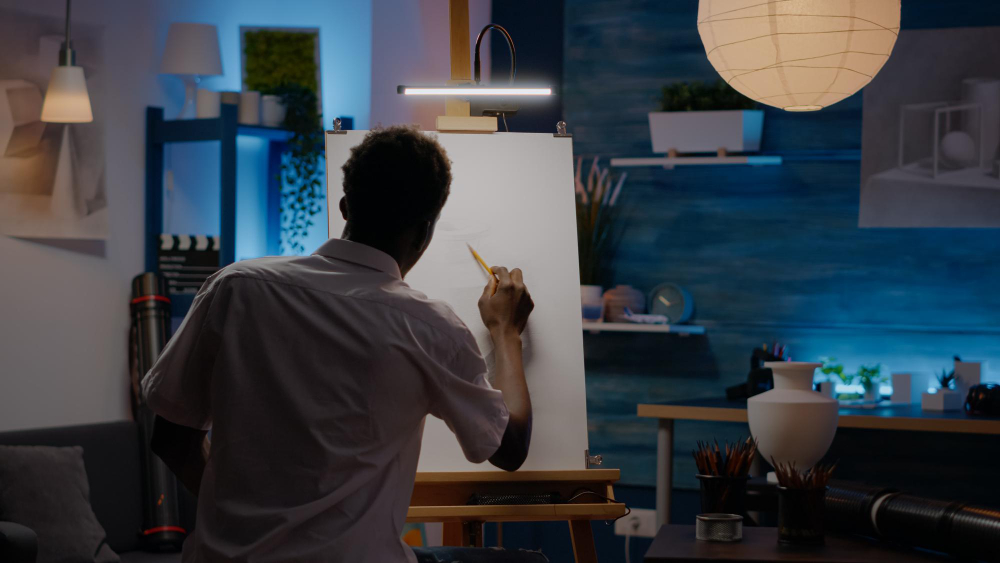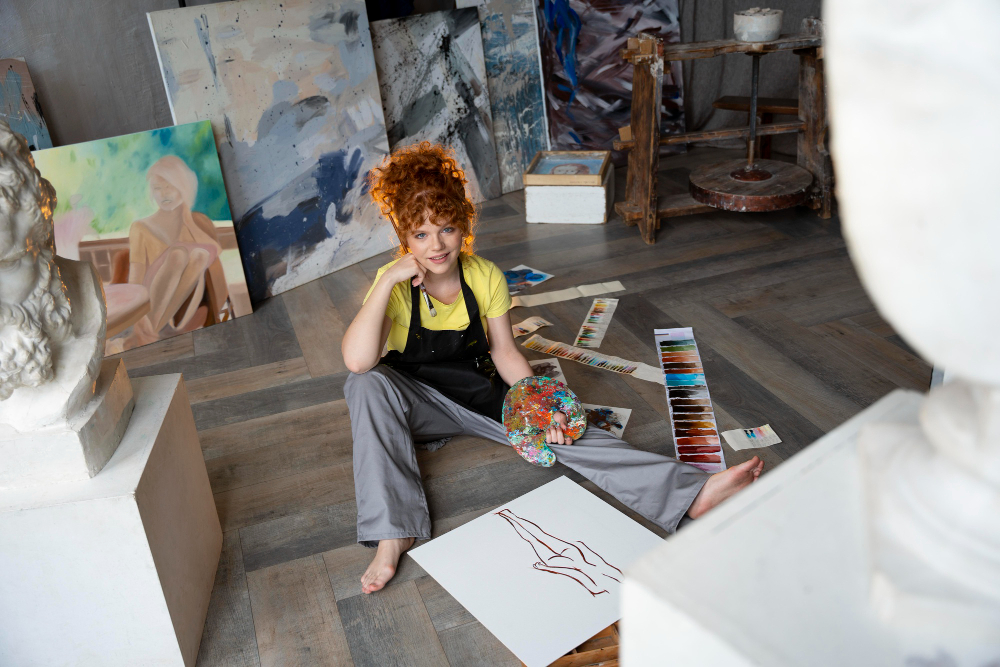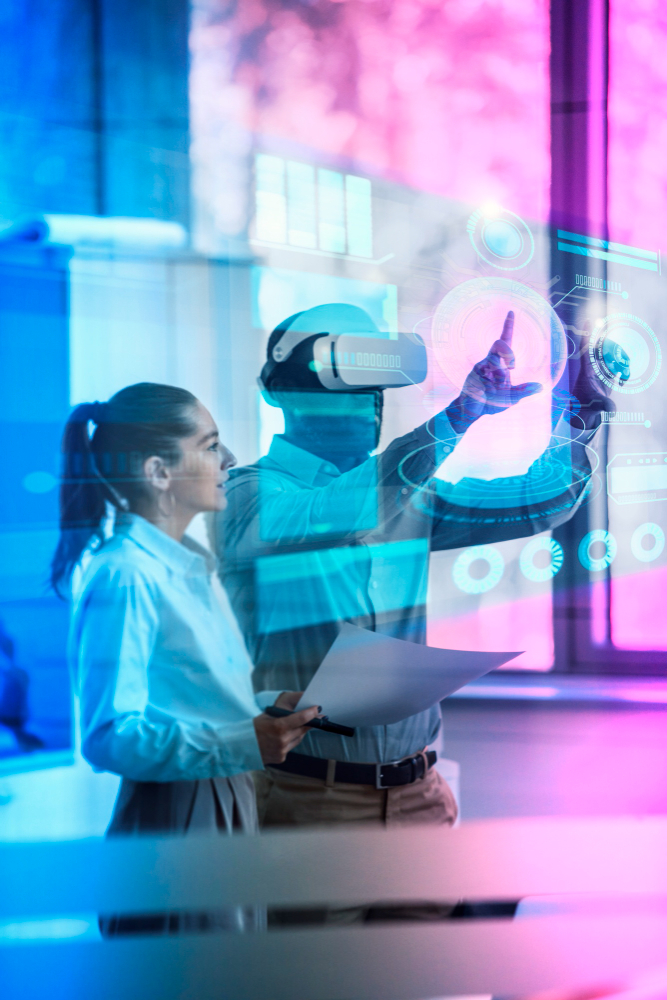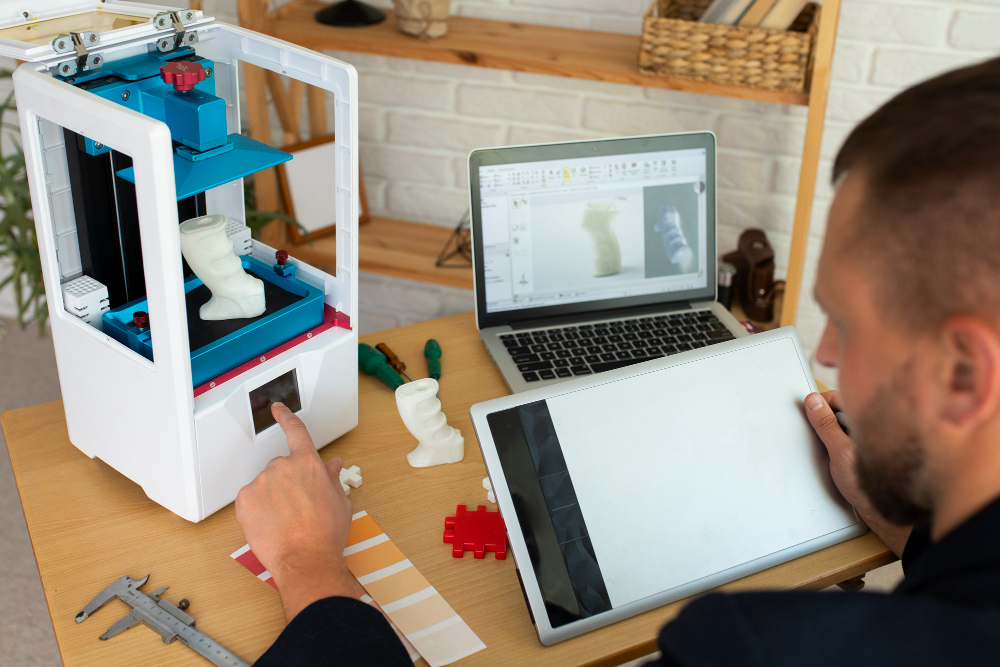Adopting AI in Art Studios: Exploring Impact
Adopting artificial intelligence in art studios significantly changes how art is made. It sparks crucial conversations about what it means to be creative, who gets to be called an artist, and what the future of art looks like. AI helps with simple tasks and can also create intricate digital art pieces. This pushes us to rethink the artist’s role and whether art made by AI is genuine.
Such a change affects how art is made and leads us to reconsider ethical issues and its effect on the art market.
This new era forces us to examine how technology and human creativity work together. It’s about more than just using new tools; it’s about understanding how they change how we think about and interact with art.
Key Takeaways
- Artists and technology now collaborate, transforming art creation and consumption.
- Ethical and perceptual debates emerge with art and technology merging.
- Technology introduces new experiences in art viewing and appreciation.
Artificial intelligence in art studios signifies a dynamic shift in art creation, dissemination, and perception. This evolution fosters a collaborative relationship between artists and technology, challenging traditional boundaries within the art community. As technology becomes more entrenched in the artistic process, it prompts vital discussions around ethics and alters how art is experienced. This transition broadens our understanding of art and enriches our engagement with art exhibitions.
Revolutionizing Art Creation
Artificial intelligence in art studios is changing how art is made, creating new ways for artists and AI to work together. This change allows artists to use new methods and ideas, helping them be more creative.
Generative AI stands out by allowing artists to try out new and unique artistic styles that once seemed impossible.
Artists are now able to blend their skills with AI to create artworks that are both innovative and captivating. This blend enhances the artistic process and opens up possibilities for what can be achieved in art.
AI as Collaborator

Introducing artificial intelligence into art studios has made it an incredible teammate, pushing human creativity to new heights. This change goes beyond just using technology to speed things up; it’s a new way of thinking about making art. Now, AI and artists work together closely. This team-up lets artists try new ideas, styles, and methods, making way for groundbreaking art.
| Aspect | AI Contribution | Impact on Art |
|---|---|---|
| New Ideas | It brings fresh ideas and views | It opens up creative possibilities |
| Style Variety | It provides a range of styles to try | It makes art more diverse |
| Technique Support | Introduces new techniques | Lifts the quality and innovation |
| Feedback | Gives analytical feedback | It helps improve artistic choices |
This partnership is changing the game, pushing past old limits. When artists team up with AI, they’re not just exploring new art forms; they also get valuable feedback that helps them polish their work. The blend of AI tools and human creativity is starting a new chapter in art, marked by ongoing trials, discoveries, and growth.
AI as a partner in art means stepping into unknown territories and getting insights that make art better. This combination reshapes art, making it more experimental, diverse, and exciting.
Impact on Artistic Identity

Artificial intelligence (AI) in art studios is changing how we think about creativity. It pushes us to reconsider what we mean by an artist’s identity. Now, thanks to AI, artists can experiment with new ideas in ways that weren’t possible before. This shift sparks meaningful conversations about what makes art original and authentic, especially when AI has a role in creating it.
As artists blend their creativity with AI, the relationship between human imagination and machine intelligence becomes crucial. This blend affects how we view art and its place in society.
Shifting Creative Processes
When art studios incorporate artificial intelligence, it’s like welcoming a new breed of creativity that changes how artists view their work and themselves. This fusion of art and technology provides fresh tools and methods, shaking up the traditional way artists create. Now, artists are navigating a changed landscape where AI’s capabilities transform their routines and decision-making. These shifts open doors to unique partnerships between artists and technology, shaping the nature and results of their creations.
| Impact on the Creative ProcessDescription | |
|---|---|
| Workflow Shifts | AI introduces innovative creation methods, changing artists’ usual ways of working. |
| Evolving Decisions | With AI’s input, artists see their choices evolving, leading to varied artistic outcomes. |
| New Collaborations | Partnerships between artists and AI merge creativity with technology. |
| Bold Experimentation | AI offers new paths for bold experiments in art. |
| Identity and Practice Transformation | The integration of AI redefines artists’ approaches and self-perception. |
This table highlights how AI is reshaping the creative practices within art studios, marking a new era in artistic identity and authorship.
Incorporating AI into art shifts the creative game, challenging and broadening artists’ views on who they are and what they can create. With AI, artists are at a crossroads where their creative paths and choices are deeply influenced by technology. This evolution fosters groundbreaking collaborations and experiments, fundamentally altering emerging art.
AI’s Influence on Originality
As art studios start using artificial intelligence, it’s vital to consider how this tech affects the uniqueness and identity of their creations. This new approach to making art is shaking up old ideas and causing us to question what makes an artist’s work truly theirs.
When artworks are made with AI, it’s hard to tell where human creativity ends, and computer work begins. This raises questions about the realness of artistic expression. Artists who use AI tools face the challenge of keeping their style while using new technology. There’s a growing debate on whether creations helped by AI are unique, pointing to worries that personal creativity might be getting lost. Thinking about AI’s place in art opens up a broader conversation about how we see artistic identity today.
Artists have to be careful to use AI in a way that adds to their work without taking away their voices. The discussion about AI in art is critical because it touches on how we define creativity and identity in a world where technology is everywhere.
Transforming Artistic Processes

Incorporating artificial intelligence in art studios is changing how artists work, making their processes more efficient and allowing for more creative freedom. AI helps with the tedious parts of art, like sorting and keeping track of work, so artists can focus more on creating. This change saves time and leads to new ways of thinking and making art.
Artists are now using AI tools like deep learning and generative adversarial networks (GANs) to push the boundaries of what’s possible. These tools offer a new level of partnership between artists and technology, making art stand out for its innovation and uniqueness. GANs, for example, let artists create complex and unexpected art pieces that go beyond traditional methods.
AI’s role in art studios also means artists can quickly try out different versions of their work. This is key for developing ideas and perfecting projects. It encourages artists to try new, data-driven techniques, moving beyond conventional art forms and discovering fresh ways to express themselves. In short, AI is sparking new ideas in art, making the creative process more dynamic and exciting.
Ethical Considerations

With the rise of artificial intelligence in art studios, the debate over AI’s role in art creation and its impact on artist rights has become more urgent. There’s a pressing need to rethink how we handle copyrights to recognize human artists and AI contributions fairly. This involves figuring out how to split intellectual property rights in a way that respects the work of both parties.
The advent of AI in the art world also raises questions about the authenticity of AI-generated art. How do we preserve the unique value of human creativity while embracing technological advancements? This dilemma highlights the importance of finding a balance that honors traditional artistic values while welcoming innovation.
To address these challenges, the art community must engage in open discussions about the ethical use of AI in art. We should aim to develop guidelines that ensure artists are fairly compensated and that the essence of human creativity remains at the heart of art, even as we explore new horizons with AI.
AI Creator Rights
When it comes to the world of art studios and the integration of artificial intelligence, the debate over AI creator rights is heating up. This discussion touches on several key issues:
- Ownership: Who owns AI-created art? Is it the human artist, the brains behind the AI algorithm, or maybe the company that developed the AI?
- Attribution: It’s tricky figuring out how to give credit for art that AI heavily influences appropriately.
- Protection: The laws around intellectual property are complex, and even more so with art made by AI.
- Recognition and Compensation: There’s a big question about whether AI should get any form of acknowledgment or payment for its role in the creative process.
Ensuring we balance these areas is crucial for maintaining a vibrant and fair atmosphere for AI in art studios.
Authenticity in AI Art
The rise of artificial intelligence in creating art raises ethical questions about the authenticity of AI-generated art, especially concerning originality and ownership. As AI changes how art is made, the true nature of authenticity becomes complicated. The blend of human creativity and AI’s capabilities prompts severe discussions about who owns an AI-created artwork and whether the creative process remains genuine.
| Concern | Description |
|---|---|
| Originality | Is AI art genuinely unique, or is it just rehashing human concepts? |
| Authorship | Where do we draw the line between AI tools and human creativity? |
| Intellectual Property | How do copyright laws apply when AI has a role in creating art? |
| Human vs. AI | How should we value and recognize the contributions of humans versus AI? |
| Ethical Frameworks | Creating rules to ensure fairness in AI-generated art. |
It’s essential to create ethical guidelines that honor AI’s innovative capabilities and the value of human creativity. This involves recognizing the uniqueness of AI art while respecting human artists’ creative process and ownership rights.
Enhancing Creativity
Integrating artificial intelligence in art workshops is a game-changer for boosting creativity. It equips artists with new tools and techniques, opening fresh avenues for artistic exploration. AI transforms how art is made and encourages artists to venture into new forms of expression through advanced machine learning algorithms. These systems can create unique art, expanding the possibilities in art creation.
The influence of AI in art workshops enhances creativity in several ways:
Immediate Feedback and Experimentation: AI-powered tools give instant feedback, enabling artists to learn styles and methods quickly. This fosters a dynamic environment for creativity.
Understanding Trends and Connecting with Audiences: AI helps identify current art trends and audience preferences, guiding artists to produce works that are more appealing to the public.
Emphasis on Creative Thinking: With AI handling repetitive tasks, artists can dedicate more time to their projects’ creative and conceptual side. This deeper focus on creativity leads to more profound artistic endeavors.
Joint Ventures in Art: The partnership between artists and AI paves the way for novel and innovative art forms. This collaboration marks a significant step forward in the evolution of art and creativity.
Incorporating AI into art practices redefines the process of art creation and enables artists to explore and express themselves in previously unimaginable ways. Through real-time feedback, trend analysis, and collaboration, AI is setting the stage for a new era of artistic expression.
The Future of Art Exhibitions
Artificial Intelligence (AI) is shaping the future of art exhibitions, making them more interactive and engaging. Through AI, art enthusiasts can now enjoy exhibitions that use virtual reality (VR) and augmented reality (AR) to create immersive experiences. These technologies allow for a more dynamic interaction with art, offering personalized stories that resonate with each visitor.
AI’s ability to tailor exhibitions according to individual preferences ensures that no two visits are identical. This customization improves visitors’ satisfaction and stimulates them to explore the art more deeply. Moreover, AI streamlines the organization of exhibitions, from selecting works to setting them up, making the process smoother for everyone involved.
Incorporating AI into art exhibitions provides valuable insights into how people interact with art. These insights help curators make informed decisions, allowing them to organize future exhibitions more accurately. As more art studios embrace AI, exhibitions are becoming more personalized and interactive, marking a significant shift in how we experience art.
Challenges and Solutions
Integrating artificial intelligence (AI) into art studios raises ethical questions and hurdles in meshing technology with art. The debate around ethics touches on whether AI-created art can be considered true art and what that means for human creativity. This requires a deep look into how AI fits into the art world. On the technical side, there’s a need for creative solutions to blend AI tools into the art-making process without losing the unique aspects of human art.
Artists face the challenge of ensuring that AI complements rather than overtakes the human element in creativity. The goal is to use AI to enhance, not replace, the artist’s work. Integrating AI in a way that respects the artist’s vision and the integrity of the art itself is crucial.
Ethical Considerations
Exploring the ethical challenges in art studios using artificial intelligence involves addressing originality, authorship, and transparency. It’s about ensuring AI-created art is original and not just a copy.
Regarding who made the art, it’s vital to share how humans and AI worked together, touching on who owns the final piece. Being open about how much AI was used in making the art helps keep everyone’s trust.
Balancing AI’s role and human creativity is vital to keeping art’s unique spirit alive. It’s about finding the right mix between technology and the human touch.
These issues are increasingly relevant in a world where AI is more common. Ensuring art remains genuine to its roots calls for thoughtful discussion and action.
Technical Integration Barriers
In integrating AI into art studios, tackling the technical challenges alongside ethical concerns is crucial. Issues like system compatibility and the need for artists to learn how to use AI tools can slow down the process. Investing in training programs designed for artists and providing continuous technical support can help.
It’s also vital to have strong data security measures to protect creative works and personal information. By addressing these barriers, we create an environment that supports creativity, efficiency, and the creation of unique artworks.
Audience Perception Shifts
How people see artificial intelligence’s involvement in art studios is genuinely changing. More and more, there’s an openness and curiosity about how AI can bring new ideas and working methods to the art world. This change is driven by AI’s creative possibilities, allowing artists to break free from traditional methods and venture into uncharted territories of creativity. AI tools and the decision to incorporate AI in creating art reshape how we view and interact with art. This shift goes beyond just the novelty of AI-created art; it’s also about what this means for the future of creative expression and art itself.
The change in perception can be described in four main points:
- Innovative Exploration: People are genuinely interested in how AI can create art that moves beyond what we’ve traditionally seen, opening up new exploration paths for artists.
- Collaborative Creation: The idea of artists and AI algorithms working together is changing our understanding of how art is made, offering a new perspective on the creative process.
- Engagement and Curiosity: The presence of AI in art studios is sparking more interest in the intersection of technology and art, leading to more people attending exhibitions and shows.
- Redefining Boundaries: The debate on what is considered art is broadening as AI challenges old ideas about creativity and authorship, encouraging people to think differently about art’s value and origins.
This evolution in how we view AI’s role in art marks a significant moment, signaling a new chapter in how art is made and appreciated.
Embracing Technological Innovation
Integrating artificial intelligence in art studios is a game-changer for creative processes. AI brings machine learning and advanced computer tools into the mix, helping artists with everything from creating art to analyzing complex data patterns. Artists can try new ideas, styles, and mediums more quickly and creatively.
Artists now use AI to simplify their workflow, handle repetitive tasks, and break free from traditional art boundaries. For example, AI image generators open up new creative possibilities, making it easier to produce innovative work. This move towards AI in art studios creates a space where artists can combine their visions with AI’s capabilities, venturing into new artistic expressions.
AI boosts creativity and collaboration in art, transforming what’s possible. It’s not just about new tools; it’s about opening new paths for artistic exploration.
Frequently Asked Questions
What Is the Meaning of Artificial Intelligence in Art?
- AI merges with art for innovative creativity.
- Ethical questions on authorship and originality arise.
- Opens new avenues for artistic expression.
What Will AI Do to the Art Industry?
- AI reshapes the art world, blending creativity and technology.
- Ethical debates intensify over human vs. AI-created art.
- Access to art expands, making it more inclusive.
Why Are Artists Against Ai-Generated Art?
- Artists worry AI blurs creative ownership.
- Emotional depth loses in AI art.
- AI challenges traditional skills‘ value.
What Is the AI That Does Art?
- AI transforms ideas into art.
- It uses algorithms for artistic expression.
- Machines now contribute to creative processes.
Conclusion
The integration of artificial intelligence in art studios is changing how art is made, shared, and viewed. It’s a big step that’s turning artists into partners with tech, pushing boundaries in the art world.
With new technology comes new questions about ethics and how people see art differently, making it clear that understanding tech’s role in art is more important than ever.
As artists and galleries use more tech, we’re heading into exciting new spaces, changing what we think of as art and how we experience art shows.